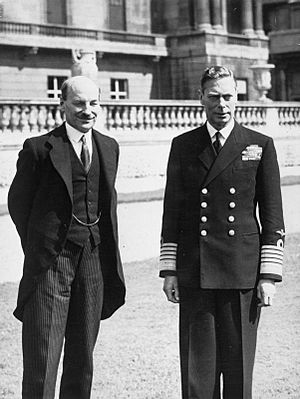Salisbury Convention facts for kids
The Salisbury Convention is an important unwritten rule in the United Kingdom. It helps explain how the House of Lords works with the elected government.
This rule means the House of Lords usually won't stop new laws. This applies if the government promised those laws in its election plan, called a manifesto. The Lords will let these laws pass their main votes, known as the second and third readings.
The idea for this rule started a long time ago. In the late 1800s, the Conservatives had more members in the House of Lords. They used a rule called the "Referendal Theory." This allowed the Lords to block laws from the Liberal government. They would wait until the public voted on them in a general election.
Things changed a lot after the 1945 United Kingdom general election. The Labour Party won by a huge amount. People felt this government had a clear instruction from the public to make big changes. Even though the Conservatives still had more members in the House of Lords, a new agreement was needed.
The fifth Marquess of Salisbury announced a new approach. He said the Lords would not try to stop Labour's main laws. This was true as long as those laws were in the party's election manifesto. From then on, the Lords would only suggest changes to manifesto bills. For other bills, they could still act as they had before.
Contents
How Things Worked Before
Before the Salisbury Convention, the House of Lords often had more Conservative members. This meant that laws proposed by the Liberal or Labour parties could struggle to pass.
After the Liberal Party split in 1886, the Lords often had a Conservative majority. This continued until changes were made in 1999.
In 1909, the Lords tried to reject a budget from the Liberal government. After this, a rule developed that they should not interfere with money matters. The Parliament Act 1911 then removed their power to vote down financial laws. It also reduced their power to delay other laws to two years. This delay was later cut to one year in 1949.
Between 1929 and 1931, a Labour government was in power but did not have a majority. The Conservative Lords used their power to delay some of their bills. They did this by suggesting changes that would ruin the bills. Most laws eventually passed because the government could threaten to use the 1911 Parliament Act.
Why the Convention Was Created
In 1945, the Labour Party won the general election by a landslide. At that time, only 16 of over 761 members in the House of Lords were linked to the Labour Party. Lord Addison led this small group.
Clement Attlee's Labour government had a clear instruction from voters. They were meant to bring in policies like nationalisation (when the government takes control of industries) and new welfare state measures. Many people thought the unelected House of Lords should not stop these laws.
Ministers and former ministers in the Lords agreed. They felt that the damage from World War II meant more government spending was needed. To avoid problems, Lord Salisbury, the Conservative leader in the Lords, made an important statement. He set out rules for how the House of Lords should handle bills that were promised in the government's election plan. These rules became the Salisbury Convention.
What the Convention Means Today
Lord Addison and Lord Salisbury agreed on the main ideas. They both remembered the difficulties that led to the 1911 Parliament Act.
Their agreement meant that:
- Bills listed in the government's election plan could be delayed for a short time. However, they would eventually pass.
- Any other bills would be fully debated and could be changed more easily.
Today, the convention allows the Lords to suggest changes to a government bill. But these changes must not be designed to completely destroy the bill.
How the Convention Has Changed
Liberal Democrats Disagree in 2005
After the Labour Party won the 2005 United Kingdom general election, the Liberal Democrats said they didn't feel bound by the Salisbury Convention. They pointed to a few reasons. Fewer people were voting, and the government had won with a smaller share of the total votes. Also, the House of Lords had changed in 1999.
When Governments Don't Have a Clear Majority
Sometimes, a government doesn't have a clear majority of seats in Parliament. This can happen with a minority government or a coalition (when two or more parties work together). In these cases, some people think the Salisbury Convention might not apply as strongly. This could give the Lords more power to delay or suggest changes to bills.
After the 2017 United Kingdom general election, there was a hung parliament. This meant no single party had a majority. The government still argued the convention applied. Baroness Evans of Bowes Park, the leader of the House of Lords, said it applied to the Conservative Party's manifesto. But she said it did not apply to their partners, the DUP.
Baroness Smith of Basildon, the Labour leader in the Lords, disagreed. She said it was "far from clear" that the convention was meant for minority governments. Some Members of Parliament (MPs) called changes made by the Lords to a 2018 law "wrecking amendments." The Lords, however, disagreed with this view.
Idea to Make the Convention a Written Rule
In 2006, Tony Blair asked Lord Cunningham to lead a committee. This committee was made up of members from both the House of Lords and the House of Commons. They looked into making many unwritten rules, including the Salisbury Convention, into formal written laws. However, these ideas were not put into action. It was decided to keep these rules as part of the UK's unwritten constitution.
See also
- Constitutional conventions of the United Kingdom
- Parliament Acts 1911 and 1949


